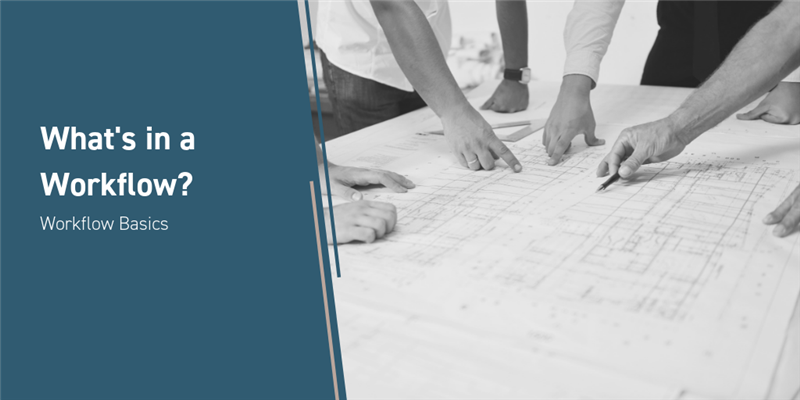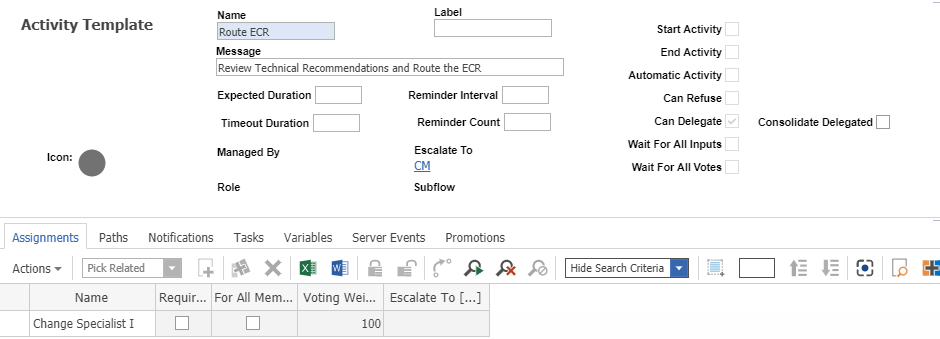If you’ve been doing research into PLM Software, one word will come up a lot: workflow. Automated workflow, manual workflow, subflow…etc. All business have workflows, from a mom-and-pop store to an aerospace R&D company. If you have a complex, or even simple process, you have a workflow. Well what is a workflow, then?
What is a workflow?
Standard Aras ECR Workflow
Workflows are how work gets done in the Aras system, with activities being assigned to Identities or Team roles for work. Then by having those assignments voted on, delegated, escalated, or otherwise re-assigned to move along the request path, once the work is complete. Workflows should mirror the real life process as much as possible, both for readability, and for completeness. Once a workflow has been started, and items have been created, overriding an active workflow with an updated one would need to be done with care.
When trying to frame out the workflow for your item, there are several best practices to keep in mind:
-
Use a cross-functional team to plan your process. Get people from every level of the process to give input. What the managerial team sees is not necessarily what the end user will need.
-
Diagram the process, maybe even using the Aras workflow interface; a picture is worth a thousand lists. Lists miss activity interactions and even simple things like the ability for a state to have an option to cancel the process.
-
Do you need a workflow? Workflows are great when your process has a list of tasks, reviews and/or signoffs, but not all processes require a workflow. If you have a very fluid process or one that does not require much user input, it may be best to skip the workflow.
With that said, a workflow is really just a chain of 2 things, along with a lot of additional options: Activities and Paths.
Activities
Workflow Activities are the units of work to be done in a process. Your activities need to encompass all possible steps in the process, even the low probability ones. A workflow will also need at least one start and one end activity. Activities can also be flagged as automatic if they do not need any human intervention. With this option set, the voting path set as default will then be followed.
An Activity will also need an Assignment, whether that is set here on the workflow to an identity or team, or left up to the Managed By role to assign ad hoc, somebody needs to be told they have something to do. Automatic activities do not need assignments. You can also distribute the voting weight per assignment. An in-depth discussion of voting weight will occur in a later blog post.
Paths
Paths are just that, the lines between activities. These represent the possible voting paths to the next (or previous) step in the process. Paths in Aras can have methods attached to them, and can also be set with an authentication lockout; either to verify the work is complete so users don’t just click through, or to protect an override path like the fast track approve in the example above. Another reason for authentication is an override path: these paths override the voting structure and force the workflow down a specific path, such as cancelling the workflow.
Configuring Your Workflow
Workflow Settings
As you can see in the above picture there is much more to an activity that just a name and an assignment. A couple of these are not really optional, but they are outside the original discussion of activities and paths so they end up here.
Activity Settings
-
Start and End Activity
-
At least one of each is required for a working workflow. Aras supports multiple start and end activities.
-
-
Automatic Activity
-
When activity activates, it is automatically voted down the default path, unless directed by an outside method.
-
-
Remaining Items
-
The delegation, refusal, and wait for all items will be covered further in a future blog post.
-
Path Settings
-
Default Path
-
This path is the default chosen for an automatic activity. Even if you do not have a default activity, it is best practice to designate a default path.
-
-
Override Path
-
This path overrides all other voting weights. Usually used with an authentication option.
-
-
Pre & Post Methods
-
Methods can be attached to the path to execute before or after voting is complete.
-
Regarding what must be filled out for a workflow to execute are the following: the paths and activities (and 1 start and 1 end flag), the assignments, and the lifecycle promotions (if the workflow is attached to a life cycle). Tasks are a place to list out tasks for the user to perform, but they have no bearing on system function unless they are set to required (and this will force the user to check them off before the assignment can be voted forward).
Conclusion
-
ArasLabs Github Examples:
-
Automatic Workflow Launch (from event or action)
-
Start Specific Workflow (based on user selection)
-
Just Ask Innovator: Open Help > Just Ask Innovator (just Help in v12) and browse or search for “workflow”



